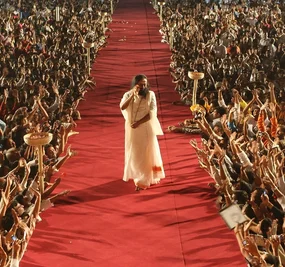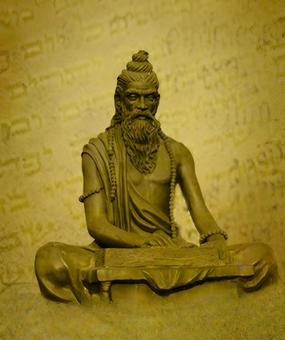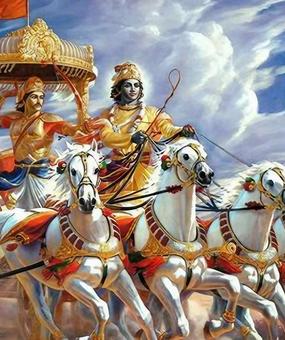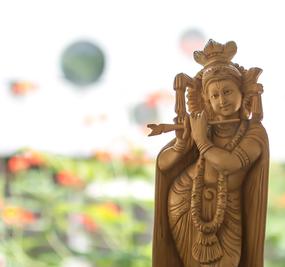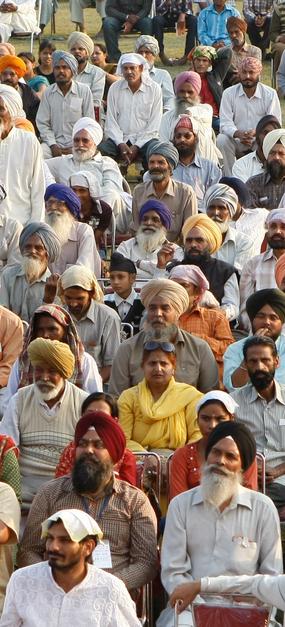What is Bhagavad Gita?
The Bhagavad Gita is an ancient tale of wisdom in the midst of chaos. It presents applied knowledge to contribute to our practice in the day to day world of work, home and family. It is a series that inspires reason and discernment to help one transcend both concepts and limitations. As Arjuna walks the path towards liberation we find ourselves right.
Commentary by Gurudev Sri Sri Ravi Shankar
Raj Vidya Raj Guhya Yoga’ is the ‘Royal Knowledge and Royal Secret’. This knowledge is secret and also sacred. This knowledge purifies soul, mind and consciousness. Krishna tells Arjuna, “Knowing it you will find the liberation; you will be free from sorrow, sufferings; free from complex that you are surrounded with.” Freedom is the ultimate desire of every soul. This royal knowledge is very pure and ultimate, and knowing it, freedom comes to you.
Every chapter signifies a different stage in our life
“Don’t think The Bhagavad Gita got over long time ago. It’s still going on everyday in each and every person’s life. Our life is all these 18 chapters of the Gita. In your life, you can see which chapter you are in now. Where are you stuck? 1st Chapter? 2nd? 3rd? … You can gauge for yourself where your life is.” “The Bhagavad Gita has the depth of the ocean and the vastness of the sky.”
Gurudev
Chapter 1:
VISADA YOGA
The distress of Arjuna. Arjuna has requested Krishna to move his chariot between the two armies as he fears losing friends and relatives as a consequence of war.
Chapter 7:
VIJNANA YOGA
Discrimination. Krishna describes the absolute reality and its illusory energy Maya.
Chapter 14:
GUNATRAYA-VIBHAGA YOGA
Krishna explains the three modes (gunas) of material nature pertaining to goodness, passion, and nescience. Their causes, characteristics, and influence on a living entity are also described.
Chapter 2:
SANKHYA YOGA
After asking Krishna for help, Arjuna is instructed into various subjects such as, Karma yoga, Gyaana yoga, Sankhya yoga, Buddhi yoga and the immortal nature of the soul.
Chapter 8:
AKSARA–BRAHMA YOGA
Importance of the last thought before death, differences between material and spiritual worlds, and light and dark paths that a soul takes after death are described.
Chapter 15:
PURUSOTTAMA YOGA
Attaining the Supreme. Krishna identifies the transcendental characteristics of God such as, omnipotence, omniscience, and omnipresence.
Chapter 3:
KARMA YOGA
Virtue of actions. Krishna explains how Karma yoga, i.e. performance of prescribed duties, but without attachment to results, is the appropriate course of action.
Chapter 9:
RAJA–VIDYA–RAJA–GUHYA
Krishna explains how his eternal energy pervades, creates, preserves, and destroys the entire universe.
Chapter 16:
DAIVASURA–SAMPAD– VIBHAGA YOGA
The Separateness of the Divine and Undivine Krishna identifies the human traits of the divine and the demonic natures.
Chapter 4:
JNANA YOGA
The path of knowledge. Krishna reveals that he has lived through many births, always teaching yoga for the protection of the pious and the destruction of the impious and stresses the importance of accepting a guru.
Chapter 10:
VIBHUTI-VISTARA-YOGA
Arjuna accepts Krishna as the Supreme Being, quoting great sages who have also done so.
Chapter 17:
SRADDHATRAYA-VIBHAGA YOGA
Krishna qualifies the three divisions of faith, thoughts, deeds, and even eating habits corresponding to the three modes (gunas)
Chapter 5:
KARMA VAIRAGYA YOGA
Renouncing the fruits of action. Arjuna asks Krishna if it is better to forgo action or to act.
Chapter 11:
VISVARUPA-DARSANA YOGA
On Arjuna’s request, Krishna displays his “universal form” Viśvarūpa.
Chapter 18:
MOKSHA–SANYASA YOGA
Deliverance and Renunciation. The conclusions of previous seventeen chapters are summed up. Krishna asks Arjuna to abandon all forms of dharma and simply surrender unto him and describes this as the ultimate perfection of life.
Chapter 6:
ABHYASA YOGA
Krishna describes the difficulties of the mind and the techniques by which mastery of the mind might be gained.
Chapter 13:
KSETRA-KSETRAJNA VIBHAGA YOGA
Separation of Matter and Spirit. The difference between transient perishable physical body and the immutable eternal soul is described.




